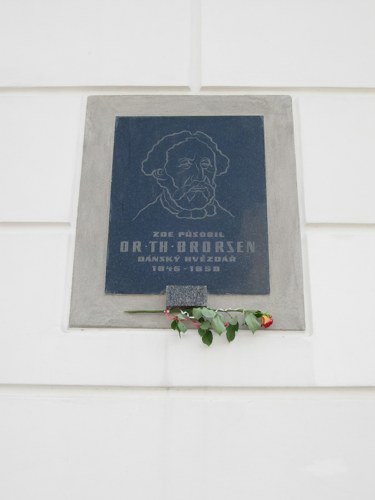back
Astronomy at Žamberk Chateau - commemorative plaque to Theodor Brorsen
- 19th century
- Žamberk Castle is part of the rich history of many noble families. During its six-hundred-year history it has had many owners. From the point of view of the history of science, the time of John Parish, a great admirer of science and astronomy in particular, who established an important observatory here in the first half of the 19th century and employed the famous astronomer Theodore Brorsen, represented a most interesting stage in its history.
- The foundations of Žamberk Castle date back to the 16th century, when it was built on the banks of the Orlice river as a Renaissance residence of Mikuláš Buben of Litice. The Bubens of Litice were the owners of the chateau for over 200 years and during their reign the chateau underwent a number of reconstructions in accordance with the contemporary changes in style and taste of its owners. At the end of the 17th century there was an extensive Baroque reconstruction, at the beginning of the 19th century the castle was rejuvenated in the Rococo style. After this last reconstruction, the Lords of Lititce abandoned the castle and sold it to the Windischgrätz family in 1809, and for a short time it was occupied by Veriand Windischgrätz, who upon coming of age sold the castle to Baron John Parish in 1815. This son of a wealthy merchant from Hamburg made Žamberk into his place of leisure and rest. Gradually, he made minor modifications to the chateau, but he left his greatest mark by building an extensive chateau park with a game preserve and also by building an astronomical observatory. He himself was a very educated amateur astronomer and decided to use his wealth to support further development of this field. He therefore hired the world-famous Danish astronomer Theodor Brorsen in Hamburg and built him an observatory in the castle. Brorsen spent a very fruitful part of his career in Žamberk. He discovered two comets, a nebula and explained the phenomenon of the Zodiacal light. From this point of view, the now defunct Žamberk observatory is one of the most important astronomical sites in our country. Unfortunately, after the death of John Parish in 1858, the whole workplace was closed down and Theodor Brorsen eventually returned to Denmark. Today, unfortunately, there is no trace of the observatory, but in 1969 a commemorative plaque designed by František Šašek was installed in the north facade of the castle, which refers to this famous episode in the history of Žamberk Castle.
- References
- Veselý, J.,Skřivánek, M.: K dějinám hvězdárny v Žamberku. Pomezí Čech, Moravy a Slezska: sborník prací ze společenských a přírodních věd. Litomyšl, 6/2005, s. 209─233.
- PH
- Show in map


